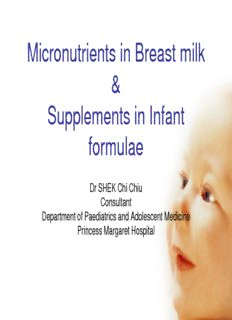
Sialic acids ( N-acetylneuraminic acid NANA) PDF
Preview Sialic acids ( N-acetylneuraminic acid NANA)
Micronutrients in Breast milk & Supplements in Infant formulae Dr SHEK Chi Chiu Consultant Department of Paediatrics and Adolescent Medicine Princess Margaret Hospital Content and Aim • Review some of the more established micronutrients in breast milk • Assess the scientific basis and benefits of supplementing these micronutrients in infant formula • Aim to provide basic knowledge in counseling on breast feeding vs infant formula “Breast Best” • Human milk is much more than a food • Energy & body building - macronutrients – protein, fat, CHO • Non energy - micronutrients - Immunological, protective and maturational properties • > 130 different compounds with biological function – Cells, enzyme, hormone, growth factors, cytokines, peptide, amino acid, vitamin, trace element etc Composition of infant formula • Standards set by Authorities – Codex Alimentarius of UN/ WHO, FDA, Scientific committee on Food of the European Commission – Mainly cover the macronutrients, vitamins and minerals • Increasing knowledge on the micronutrients and advancement in technology – Attempts to supplement formulae with various micronutrients to mimic human milk – For better health of infants ± better marketing Oligosaccharides(低聚糖) / Prebiotics (益生素) / Soluble fibre • Oligosaccharides are sugars consisting of approximately 2-20 saccharide units • resistant to enzymatic digestion in the upper gastrointestinal tract – remain intact in small intestine • Similar molecular structure with the binding sites in respiratory, gastrointestinal and urinary tracts – act as competitive receptors – bind to pathogens and prevent their adhesion to the gastrointestinal epithelium • as substrates for bacterial fermentation in the colon (Prebiotics effect) – Favour the growth of bifidobacteria and lactobacilli ↓ potentially pathogenic bacteria of the colonic flora Effects of Oligosaccharides • bind to specific receptors on mucosal cell surfaces and to act as receptor analogues thereby preventing adhesion of a number of bacterial and viral pathogens. • undigested oligosaccharides may serve as substrates for colonic fermentation – Enhance growth of Bifidobacteria and lactobacilli Pediatr Res 61: 2–8, 2007
Description: